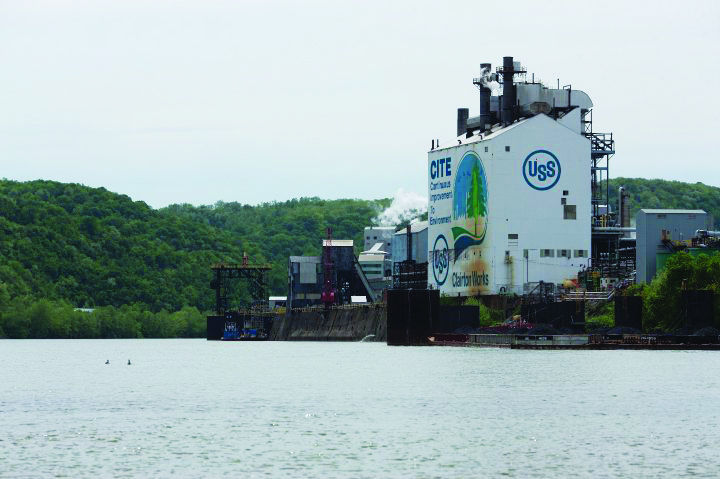Air study finds elevated cancer risk in Oakland
December 5, 2013
Pitt students are breathing in pollution at concentrations more than 100 times greater than the acceptable level, according to a recent study by the Pitt Graduate School of Public Health.
The study, known as the Pittsburgh Regional Environmental Threats Analysis, was released online in August as the third in a series of health assessments. The focus of the study is a class of elements and compounds known as hazardous air pollutants, or air toxics. These pollutants come from a variety of sources ranging from coal-fired power plants to diesel engines. According to the study, Pittsburghers are twice as likely to get cancer from these toxics as residents of neighboring counties.
The model for the study comes from the U.S. Environmental Protection Agency’s National-scale Air Toxics Assessment, which sets a one-in-a-million cancer risk as the acceptable level. The average national risk, according the EPA’s 2005 NATA release, is much higher, at 50 in a million. While the average risk in Allegheny County is 28 cancer cases per 1 million people, certain parts of Pittsburgh, including Oakland, have levels in excess of 100 per million.
West Elizabeth, a southern Allegheny County borough located near Clairton Coke Works, tops the list. Clairton Coke Works is a plant that converts coal into “coke,” a fuel for smelting iron. In West Elizabeth, about 1,314 per 1 million people would get cancer because of inhaling air toxics, according to the Pitt researchers’ report.
U.S. Steel, the company that runs the Clairton Coke Works, was unavailable for comment after multiple requests for comment over several days.
Although the coke plant is one of the largest polluters in the region, according to the study, the greatest cancer risk is diesel particulate matter. Many diesel engines used in transportation, freight hauling, construction and other sectors emit diesel exhaust, which contains these toxic particles.
According to Jamin Bogi, outreach coordinator at the Pittsburgh-based Group Against Smog and Pollution, this report confirms what his organization has known for years.
“We know diesel is a problem, we know that the coke works is a problem,” Bogi said, adding that his group, which a federal grant primarily funds, works to reduce diesel emissions and push companies to implement cleaner processes.
Bogi said his group put air monitors on bicycles and rode around the city as part of an ongoing project. They found that the difference in pollution can vary greatly from one street to the next. For example, he said the air quality on Liberty Avenue, a busy thoroughfare between Oakland and East Liberty, was often much worse than the air quality on adjacent side streets.
Drew Michanowicz, a doctoral student at Pitt who worked on the assessment, said such pockets of concentrated pollution are a result of Pittsburgh’s complex topography, in which low-lying valleys or busy corridors separated by buildings tend to trap emissions.
While diesel particulate matter remains a problem, Michanowicz said it’s a mistake to blame diesel-powered buses.
“One bus effectively removes 60 cars off the roadways,” Michanowicz said.
He added that he encourages people to use public transportation.
Jim Ritchie, spokesman for the Allegheny County Port Authority, said the authority has reduced its bus fleet particulate emissions by 96 percent since 1991. Aqccording to Ritchie, the Port Authority began to use a biodiesel blend in buses — a policy the state mandated in 2010 — in 2009.
Public transportation use in the United States reduces carbon emissions by 37 million metric tons annually, according to a report the American Public Transportation Association, a nonprofit based in Washington, D.C., released in 2008.
But Michanowicz said many of the dirtiest diesel engines are not found on the road. Rather, these are engines from barges, trains and construction vehicles, as well as industrial equipment such as compressors and conveyor belts.
“These are predominantly run on diesel engines that don’t have the same kind of regulations [as buses] yet,” Michanowicz said.
Michanowicz, his team at the Graduate School of Public Health and the Breathe Project, a local nonprofit coalition of individuals and businesses that aim to improve air quality in Pittsburgh, have put together recommendations for the city on how to reduce these air-toxics levels.
These recommendations include the enforcement of Pittsburgh’s Clean Air Act of 2010, which requires publicly funded development projects in Pittsburgh to reduce diesel emissions from their project construction vehicles. The recommendations also include the enforcement of air toxics guidelines for companies applying for permits related to hydraulic fracturing and the ensurement that the Allegheny County Health Department’s upcoming sulfur dioxide plan includes strong control measures for coke ovens.
Although air pollution poses a health risk, Michanowicz he said the cancer risk from air toxics was minor compared to the risk from tobacco smoke, adding that a smoker has a cancer risk of about 150,000 in a million people.
In addition to health risks associated with air toxics, there are also risks pertaining to Pittsburgh’s future as a thriving post-industrial city.
“If you look at Pittsburgh’s dramatic revitalization, it is not based upon new steel mills,” Bogi said, adding that diversification led to Pittsburgh’s economic improvement.
Bogi, who was raised in Greensburg but lived for years in Seattle before moving to Pittsburgh, said the city has many advantages, including low cost of living and job growth.
Bogi said it would be difficult to determine how many people eliminated Pittsburgh as a place to live or start a business because of the city’s poor air quality, but that the air quality certainly isn’t attracting anyone.
“We need clean air for a strong economy here,” Bogi said.
Michanowicz agreed.
“These environmental and infrastructural challenges the city faces are high on my list,” Michaowicz said.




